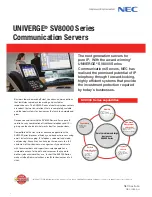
each
server
to
attach
to
the
same
virtual
LAN
or
subnet.
Either
one
of
the
integrated
Ethernet
controllers
can
be
configured
as
the
primary
Ethernet
controller.
If
you
have
configured
the
controllers
for
failover
and
the
primary
link
fails,
the
secondary
controller
takes
over.
When
the
primary
link
is
restored,
the
Ethernet
traffic
switches
back
to
the
primary
Ethernet
controller.
(See
the
operating-system
device-driver
documentation
for
information
about
configuring
for
failover.)
Important:
To
support
failover
on
the
blade
server
Ethernet
controllers,
the
Ethernet
switch
modules
in
the
BladeCenter
unit
must
have
identical
configurations.
Blade
server
Ethernet
controller
enumeration
The
enumeration
of
the
Ethernet
controllers
in
a
blade
server
is
operating-system
dependent.
You
can
verify
the
Ethernet
controller
designations
that
a
blade
server
uses
through
the
operating-system
settings.
The
routing
of
an
Ethernet
controller
to
a
particular
I/O-module
bay
depends
on
the
type
of
blade
server.
You
can
verify
which
Ethernet
controller
is
routed
to
which
I/O-module
bay
by
using
the
following
test:
1.
Install
only
one
Ethernet
switch
module
or
pass-thru
module
in
I/O-module
bay
1.
2.
Make
sure
that
the
ports
on
the
switch
module
or
pass-thru
module
are
enabled
(click
I/O-module
Tasks
→
Management
→
Advanced
Management
in
the
management
module
Web-based
user
interface).
3.
Enable
only
one
of
the
Ethernet
controllers
on
the
blade
server.
Note
the
designation
that
the
blade
server
operating
system
has
for
the
controller.
4.
Ping
an
external
computer
on
the
network
connected
to
the
switch
module
or
pass-thru
module.
If
you
can
ping
the
external
computer,
the
Ethernet
controller
that
you
enabled
is
associated
with
the
switch
module
or
pass-thru
module
in
I/O-module
bay
1.
The
other
Ethernet
controller
in
the
blade
server
is
associated
with
the
switch
module
or
pass-thru
module
in
I/O-module
bay
2.
If
you
have
installed
an
I/O-expansion
card
in
the
blade
server,
communications
from
the
expansion
card
are
routed
to
I/O-module
bays
3
and
4,
if
these
bays
are
supported
by
your
BladeCenter
unit
type.
You
can
verify
which
controller
on
the
card
is
routed
to
which
I/O-module
bay
by
performing
the
same
test
and
using
a
controller
on
the
expansion
card
and
a
compatible
switch
module
or
pass-thru
module
in
I/O-module
bay
3
or
4.
Configuring
a
RAID
array
Configuring
a
SAS
RAID
array
applies
to
a
blade
server
and
MPE
where
a
SAS
hard
disk
drive
is
installed
in
both
the
blade
server
and
the
MPE
unit.
Two
SAS
hard
disk
drives
can
be
used
to
implement
and
manage
RAID
level-0
(striping)
or
RAID
level-1
(mirror)
arrays
in
operating
systems
that
are
listed
on
the
ServerProven
list
at
http://www.ibm.com/servers/eserver/serverproven/compat/us/.
Use
the
LSI
Configuration
Utility
program
to
configure
the
SAS
RAID
(see
“Using
the
LSI
Logic
Configuration
Utility
program”
on
page
52).
If
an
optional
BladeCenter
Storage
Expansion
Unit
3
is
installed,
you
can
use
it
to
control
all
of
the
SAS
hard
disk
drives
installed
in
the
blade
server.
You
enable
this
feature
using
the
Configuration/Setup
Utility
program
(see
“Using
the
Configuration/Setup
Utility
program”
on
page
44).
Chapter
4.
Configuring
the
blade
server
51
Содержание BladeCenter LS21 Type 7971
Страница 3: ...BladeCenter LS21 Type 7971 and LS41 Type 7972 Installation and User s Guide...
Страница 24: ...12 BladeCenter LS21 Type 7971 and LS41 Type 7972 Installation and User s Guide...
Страница 78: ...66 BladeCenter LS21 Type 7971 and LS41 Type 7972 Installation and User s Guide...
Страница 82: ...70 BladeCenter LS21 Type 7971 and LS41 Type 7972 Installation and User s Guide...
Страница 83: ......
Страница 84: ...Part Number 42C4897 Printed in USA 1P P N 42C4897...
















































